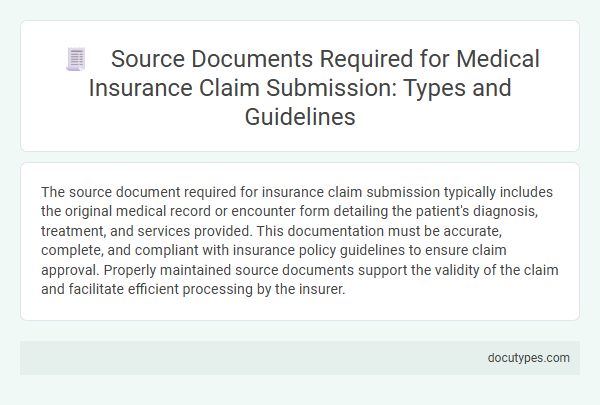The source document required for insurance claim submission typically includes the original medical record or encounter form detailing the patient's diagnosis, treatment, and services provided. This documentation must be accurate, complete, and compliant with insurance policy guidelines to ensure claim approval. Properly maintained source documents support the validity of the claim and facilitate efficient processing by the insurer.
Introduction to Medical Insurance Claim Documentation
What source document is required for insurance claim submission in medical settings? Source documents include medical records, physician's notes, and diagnostic reports that verify the treatment provided. These documents ensure accurate claim processing and support reimbursement from insurance providers.
Importance of Accurate Source Documents
Source documents such as medical records, physician's notes, and billing statements are essential for insurance claim submission. Accurate source documents ensure that the information submitted matches the patient's treatment and services received, reducing the risk of claim denials or delays. Your attention to detail in providing precise documentation supports faster processing and proper reimbursement from insurance providers.
Common Types of Source Documents Required
Submitting an insurance claim requires specific source documents to verify the medical services provided. These documents ensure accurate processing and approval of your claim.
- Medical Records - Detailed documentation of diagnosis, treatment, and clinical notes from healthcare providers.
- Itemized Bills - Clear statements listing all procedures, medications, and services rendered with corresponding costs.
- Claim Forms - Official insurance forms completed by the healthcare provider or patient to initiate the claim process.
Providing these common source documents helps facilitate timely and accurate insurance claim submissions.
Patient Identification and Demographic Records
Source documents required for insurance claim submission must include accurate patient identification and demographic records. These records verify the patient's identity and ensure the claim corresponds to the correct individual.
Essential patient information includes full name, date of birth, address, and insurance policy number. Verifying these details reduces claim denials and expedites the reimbursement process.
Physician’s Prescription and Referral Letters
Physician's prescriptions and referral letters are essential source documents for insurance claim submissions in the medical field. These documents provide verifiable evidence of medical necessity and treatment authorization.
- Physician's Prescription - Details the prescribed medication or treatment directly from a licensed medical professional, serving as proof of the patient's medical need.
- Referral Letter - Authorizes a patient's consultation or treatment by a specialist, ensuring that the claim aligns with approved medical procedures.
- Insurance Validation - Both documents help validate the claim by confirming the legitimacy of medical services rendered, facilitating smoother insurance processing.
Detailed Medical Reports and Clinical Notes
Detailed medical reports and clinical notes serve as essential source documents for insurance claim submission. These documents provide comprehensive information about diagnosis, treatment plans, and patient progress. Your insurance provider relies on their accuracy and completeness to process claims effectively.
Hospital Discharge Summaries and Admission Notes
Hospital discharge summaries are essential source documents for insurance claim submission, providing a comprehensive overview of the patient's treatment, diagnosis, and outcomes during hospitalization. These summaries ensure accurate verification of medical services rendered and support claim approval.
Admission notes are critical documents that detail the patient's initial condition, reason for admission, and preliminary assessments by medical professionals. Insurance providers rely on admission notes to validate the necessity and timing of hospital care in the claims process.
Original Medical Bills and Payment Receipts
Original medical bills and payment receipts are essential source documents required for insurance claim submission. These documents provide detailed information about the medical services rendered and proof of payment, which are critical for claim verification.
Original medical bills must include patient details, treatment descriptions, dates of service, and itemized costs. Payment receipts serve as evidence that the patient has settled all or part of the medical expenses. Insurance companies rely on these documents to assess the legitimacy of the claim and ensure accurate reimbursement.
Insurance Claim Forms and Supporting Declarations
Insurance claim submission requires accurate source documents to ensure proper processing and approval. Your insurance claim forms must be accompanied by specific supporting declarations to validate the claim details.
- Insurance Claim Forms - These standardized documents contain essential patient, provider, and treatment information necessary for claim evaluation.
- Supporting Medical Declarations - Signed statements from healthcare professionals confirming diagnosis, treatment, and medical necessity.
- Patient Authorization - A declaration allowing the insurance company to access medical records and verify the claim's authenticity.
What Source Document Is Required for Insurance Claim Submission? Infographic

